Family Mantidae
A praying mantis is a beneficial insect that helps control populations of other insects that can be pests to crops and gardens. It is also important in food webs, serving as prey for other animals, such as birds and spiders.
Praying mantises are found in many regions around the world, with over 2,400 species known to exist. They are widely distributed and are found in a variety of habitats, from forests to deserts and grasslands.
Praying mantises are native to tropical and subtropical regions but have also been introduced to many other parts of the world, including North America, Europe, and Australia. Some species have become established in these areas, while others are considered invasive.
In general, praying mantises is most abundant in areas with warm, moist climates and plenty of vegetation, which provides them with plenty of food and shelter. However, some species of praying mantises are also adapted to live in dry, desert-like environments, where they can be found hiding in crevices and waiting for prey.
Praying mantis is a predatory insect known for its distinctive appearance and behavior. It is characterized by its long, slender body and large, triangular head, capable of turning 180 degrees. Praying mantis has two large, compound eyes and several simple eyes, which give excellent vision, and it has long, powerful front legs used to catch and hold their prey.
Praying mantises are generally green or brown in color, which helps them to blend in with their surroundings and avoid detection by prey. They have a unique appearance, with their long, narrow bodies and upright posture, which gives them a distinctive, almost praying appearance.
Praying mantises are carnivorous and feed on various insects, including flies, moths, and beetles. They are ambush predators, waiting motionless for prey to come within reach and then striking with lightning speed. They use their front legs to grasp and hold their prey and then use their sharp mandibles to bite and kill it.
Praying mantises are also known for their unusual mating behavior. In some species, the female may eat the male during or after mating. However, this behavior is not universal and varies between species.
Discover 10 fascinating praying mantis facts.
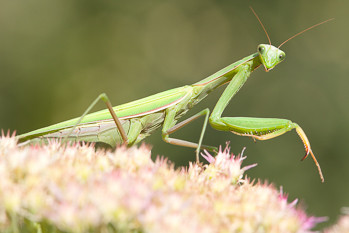 |
Mantis religiosa
Also known as the European mantis, this species can be found throughout Europe, Asia, and Africa, as well as North America, where it is considered introduced. It is a large and striking insect, growing to a length of around 3-3.5 inches (7-9 cm), with a distinctive green, yellow, or brown coloration and long, slender legs. It has two black eyespots with a yellow or white center at the base of the legs. |
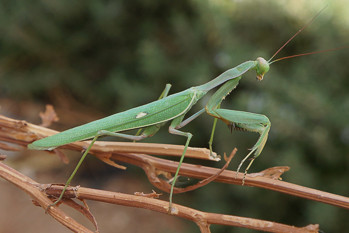 |
Sphodromantis viridis
Also known as the African mantis, giant African mantis, and bush mantis, this species is native to Africa. It is a large mantis, about 4 inches long (10 cm), with a body typically bright green or dull brown. As adults, both females and males have distinctive white spots on their wings. They also have a yellowish color on their inner foreleg, distinguishable from the black eyespot and white dots of the European mantis. This species is a popular choice for insect enthusiasts and hobbyists. |
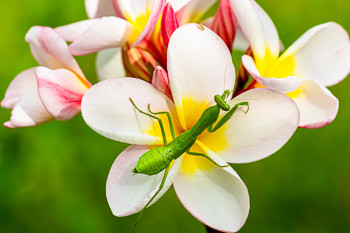 |
Hierodula patellifera
Also known as the giant Asian mantis, Asian mantis, Indochina mantis or Harabiro Mantis, this species is native to Southeast Asia. Males are about 1.7-2.5 inches long (45-65 mm), and females 2.5-2.9 inches (65-75 mm). Individuals can vary from green to brown in color. |
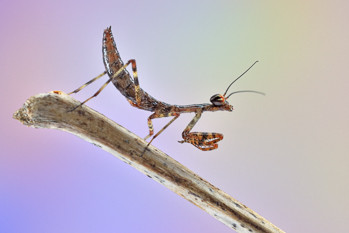 |
Stagmomantis californica
Also known as the California mantis, this praying mantis is native to the western United States and northern Mexico. It measures up to 2-3 inches (5-7 cm) in length and can be green, yellow, and brown, with adults typically displaying dark transverse bands on the top of their abdomen. The wings are speckled or infused with dark brown or black, and their hindwings have a purplish hue. The inner forelegs are orange in color, and there are some black spots located near the mandibles. |
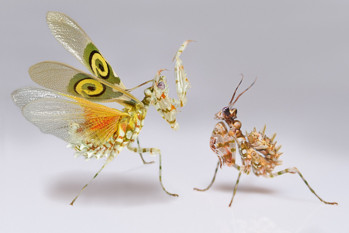 |
Pseudocreobotra wahlbergi
Also known as the flower mantis or Wahlberg’s mantis, this species is native to Africa and is known for its distinctive appearance, with a body that resembles a flower petal. They are usually green or brown in color, with intricate patterns and shapes on their body that help them blend in with their surroundings. They are about 1.5 inches long (4 cm). They prefer to prey on flying insects and spiders, but if unavailable, will eat virtually any insect. |
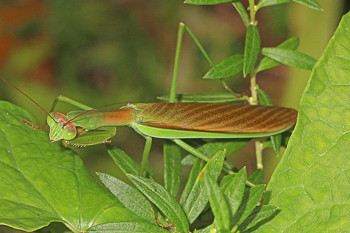 |
Tenodera sinensis
Also known as the Chinese mantis, this species is native to Asia and is one of the largest mantises found in North America, where it has been introduced. This is a long, slender praying mantis reaching up to 4.3 inches (11 cm). Its color can range from green to brown, with a green stripe along the edges of its front wings in brown individuals. The female Chinese mantis produces semi-spherical oothecae, each containing up to 300 eggs, which are attached to vegetation like bushes and small trees. |
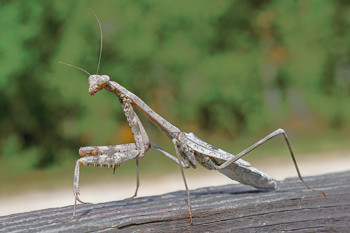 |
Stagmomantis carolina
Also known as the Carolina mantis, this species is native to North America. It measures 2-2½ inches (5-6 cm) in length. The Carolina mantis has a dusty brown, gray, or green coloration, which serves as camouflage in various environments. One unique characteristic of the Carolina mantis is that its wings only extend three-quarters of the way down the abdomen in mature females. Both adult males and females have a dark-colored dot on each forewing (outer wings), which may be partially hidden in individuals with a brown or dark morph. |
The life cycle of a praying mantis includes several stages: egg, nymph, and adult.
It is worth noting that the exact number of molts and the length of the life cycle can vary between species and can be influenced by factors such as temperature, food availability, and the presence of predators. Some species of praying mantises have a relatively short life cycle, living only a few months, while others can live for several years.
Praying mantises are considered beneficial insects for several reasons:
In general, praying mantises are beneficial insects that play important roles in maintaining the balance of ecosystems. They are not only important predators but also play a role in the food webs of many ecosystems, serving as both predator and prey. By attracting praying mantises to your garden, you can help to support the health of your local ecosystem and control pest populations.
Attracting praying mantises to your garden can be a great way to help control pest populations and support the health of your local ecosystem. Here are some steps you can take to attract praying mantises to your garden:
By following these steps, you can help to create a welcoming environment for praying mantises in your garden, which can help to support the health of your local ecosystem and control pest populations. It is important to remember that praying mantises are predators and may also feed on other beneficial insects, such as ladybugs, so it is important to balance their presence in your garden with other beneficial insects.
Florian Teodor, Bakusova, Sebastian Janicki, bulinko, Florian Teodor, Sari ONeal, Shutterstock, Bernard Dupont, Aiko, Thomas & Juliette+Isaac, Flickr
Create a membership account to save your garden designs and to view them on any device.
Becoming a contributing member of Gardenia is easy and can be done in just a few minutes. If you provide us with your name, email address and the payment of a modest $25 annual membership fee, you will become a full member, enabling you to design and save up to 25 of your garden design ideas.
Join now and start creating your dream garden!
Create a membership account to save your garden designs and to view them on any device.
Becoming a contributing member of Gardenia is easy and can be done in just a few minutes. If you provide us with your name, email address and the payment of a modest $25 annual membership fee, you will become a full member, enabling you to design and save up to 25 of your garden design ideas.
Join now and start creating your dream garden!